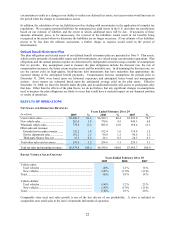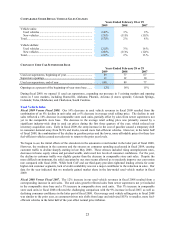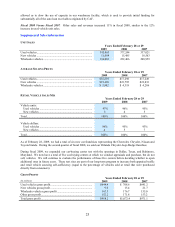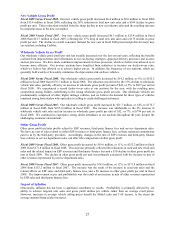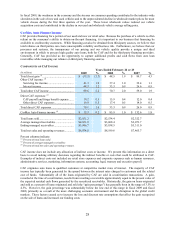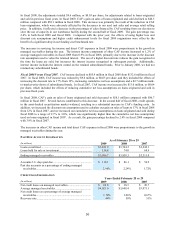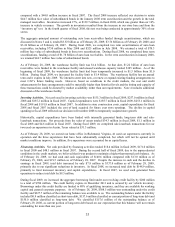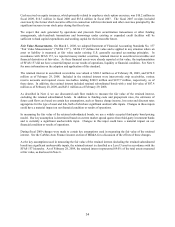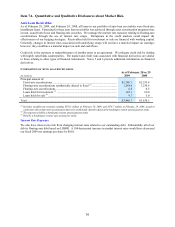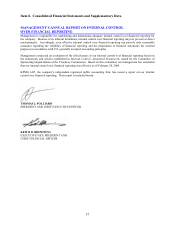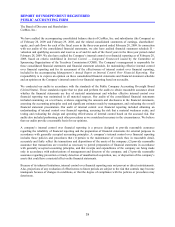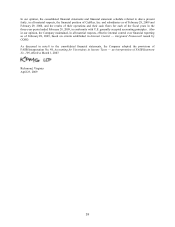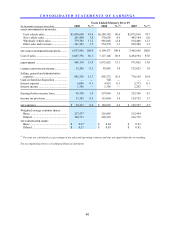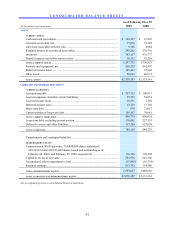CarMax 2009 Annual Report Download - page 38
Download and view the complete annual report
Please find page 38 of the 2009 CarMax annual report below. You can navigate through the pages in the report by either clicking on the pages listed below, or by using the keyword search tool below to find specific information within the annual report.32
OPERATIONS OUTLOOK
Store Openings and Capital Expenditures
We currently estimate gross capital expenditures will total approximately $20 million in fiscal 2010, compared with
$185.7 million in fiscal 2009 and $253.1 million in fiscal 2008. This reduction reflects our decision to temporarily
suspend store growth and the related reduction in both construction and land purchases for future store openings. At
the date we announced the suspension, we had four stores under construction. We opened the store in Potomac
Mills, Virginia. The stores in Augusta, Georgia; Cincinnati, Ohio; and Dayton, Ohio, were substantially completed
at the end of fiscal 2009, but they will not be opened until market conditions improve. Until we resume store
growth, capital spending will be incurred primarily for maintenance capital items. Based on the relatively young
average age of our store base, maintenance capital has represented a very small portion of our total capital spending
in recent years.
Fiscal 2010 Expectations
As a result of the unprecedented declines in traffic and sales and the continuing volatility in the asset-backed
securitization market, we do not believe we can make a meaningful projection of fiscal 2010 sales or earnings.
However, assuming that sales trends do not improve from fourth quarter fiscal 2009 levels and given all of the
uncertainties in the economy, we would anticipate a double-digit decline in comparable store used unit sales in fiscal
2010, particularly early in the year.
Recent credit spreads in the public asset-backed securitization market have been significantly higher than the
spreads implicit in our warehouse facility. As a result, we estimate CAF income will be reduced by incremental
funding costs of between $60 million and $85 million before taxes, or $0.17 to $0.24 per share, upon refinancing the
$1.22 billion that was funded in the warehouse facility at the end of fiscal 2009. The Federal Reserve launched the
Term Asset-Backed Securities Loan Facility (“TALF”) program in March 2009, and it will continue through
December 2009, unless extended. The TALF program is intended to facilitate the issuance of asset-backed
securities and to improve market conditions for these securities. Prior to the launch of this program, there had been
minimal new issuances of automotive asset-backed securities for several months. In April 2009, we completed a
term securitization totaling $1.0 billion of auto loan receivables, which was eligible for investors to utilize the TALF
program.
Absent further substantial deterioration in sales and earnings, and given the assumptions set forth above, we believe
we will remain in compliance with our financial covenants in fiscal 2010.
RECENT ACCOUNTING PRONOUNCEMENTS
For a discussion of recent accounting pronouncements applicable to CarMax, see Note 17.
FINANCIAL CONDITION
Liquidity and Capital Resources
Operating Activities. We generated net cash from operating activities of $264.6 million in fiscal 2009, $79.5
million in fiscal 2008 and $136.8 million in fiscal 2007. Cash generated by operating activities was $185.1 million
higher in fiscal 2009 compared with fiscal 2008, primarily reflecting the significant decrease in inventory in fiscal
2009, partially offset by the decline in net earnings. Despite increasing our store base by 12%, we reduced
inventories 28%, or $272.6 million, in fiscal 2009 compared with an increase in inventory of $139.7 million in fiscal
2008. In fiscal 2009, we dramatically reduced our used vehicle inventory levels to bring them in line with the lower
sales rate. In fiscal 2008, the inventory increase reflected the combination of additional inventories needed to
support the expansion of our store base and the expansion of an “inventory up” test in select stores to determine
whether a modest expansion of onsite vehicle inventory, generally in the range of 50 to 100 cars per store, would
have a favorable effect on sales. Our retained interest in securitized receivables increased $77.5 million in fiscal
2009 compared with a $68.5 million increase in fiscal 2008. The fiscal 2009 growth reflected increases in the
required excess receivables and the amount of retained subordinated bonds we hold, partially offset by a decrease in
interest-only strip receivables.
Cash generated by operating activities was $57.3 million lower in fiscal 2008 compared with fiscal 2007. The
decrease resulted from a higher level of working capital investment in fiscal 2008, combined with the $16.6 million
decrease in net earnings. Our retained interest in securitized receivables increased $68.5 million in fiscal 2008


